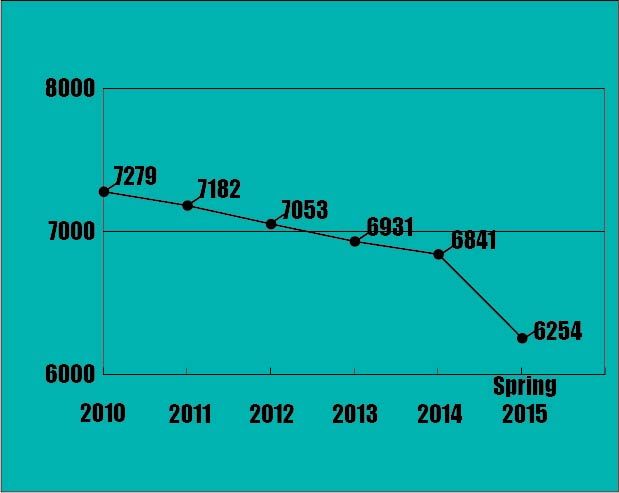UNA enrollment slips again; credit hour production dips
January 29, 2015
The university received bad news again this year when spring enrollment numbers were released last week.
As officials seek ways to increase attendance to UNA, the numbers continue to fall. For the spring semester, 6,254 students are enrolled in classes, showing a 1.09 percent decrease from last spring.
“The university’s main focus is enrollment and retention,” said Interim Assistant Vice President for Enrollment Management Vince Brewton. “Every day I’m in meetings, and they’re addressing enrollment and bringing more students to the university.”
Director of Institutional Research Andrew Luna said the numbers for the spring semester typically come in below those of the preceding fall semester at universities across the U.S.
“You have people who graduate in December, and the people who decided college just isn’t for them after one semester.” Luna said. “Typically at UNA, our spring enrollment is about 93 to 94 percent of what we had in the fall.”
The data also shows credit hour production fell approximately 2 percent.
Luna said the number of credit hours produced is somewhat more important than enrollment for officials because that shows how much revenue the university will make from tuition.
“Credit hour production is essentially where our money comes from because people pay per credit hour,” he said. “For example, if we had 8,000 students on this campus, it would look really good enrollment wise, but if they only took 2 hours, we would have to shut down.”
Administrators base the university’s budget on the revenue expected from tuition, which is determined by credit hours taken.
“Enrollment shows you are bringing in more students,” Luna said. “Credit hour production is showing money you’re getting to operate the institution.”
University Communications Director Bryan Rachal said he expects credit hour production was affected by new university standards that allow many students to graduate with 120 hours.
Officials said the change was made to allow students who take 15 hours per semester to graduate in four years.
Luna said while it is too early to tell what effect the new standards will have, it is possible the change affected the credit hour production numbers.
“One year of data can’t really show us that,” he said. “We should be able to tell over time.”
Brewton said although he had not received a copy of the spring enrollment data, he expected enrollment and credit hour production are both affected by the new graduation requirements because many students likely graduated in December rather than staying until May.
A study conducted by the Office of Institutional Research showed many students who were accepted to UNA but decided not to attend chose community colleges such as Northwest-Shoals.
Northwest-Shoals Media Relations Manager Trent Randolph said while the final enrollment numbers were not available as of Jan. 23, officials expected to see about a one percent increase in enrollment, the same as the 2014 fall semester increase.











